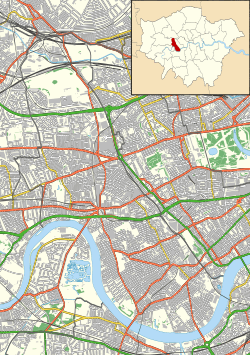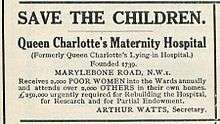Queen Charlotte's and Chelsea Hospital
| Queen Charlotte's and Chelsea Hospital | |
|---|---|
| Imperial College Healthcare NHS Trust | |
.jpg) Queen Charlotte's and Chelsea Hospital main building. | |
 Location within Hammersmith and Fulham | |
| Geography | |
| Location |
Du Cane Road London W12 0HS[1] |
| Organisation | |
| Care system | NHS England |
| Hospital type | Specialist |
| Affiliated university | Imperial College London |
| Services | |
| Emergency department | No |
| Speciality | Maternity, women's and children's services |
| History | |
| Founded | 1739 |
| Links | |
| Website |
www |
Queen Charlotte's and Chelsea Hospital is one of the oldest maternity hospitals in Europe, founded in 1739 in London. Until October 2000,[2] it occupied a site at 339–351 Goldhawk Road, Hammersmith, but is now located between East Acton and White City, adjacent to the Hammersmith Hospital. It is managed by the Imperial College Healthcare NHS Trust.
History

The hospital strictly dates its foundation to 1739 when Sir Richard Manningham founded a hospital of lying-in beds in a 17-room house in Jermyn Street.[3] ("Lying-in" is an archiac term for childbirth, in reference to the period of bedrest expected of mothers in their postpartum confinement.) This was called the General Lying-in Hospital, and was the first of its kind in Britain. In 1752 the hospital relocated from Jermyn Street to St Marylebone and first became a teaching institution.[4][lower-alpha 1] On 10 January 1782 a licence was granted to the hospital charity by the Justices of the County of Middlesex (at that time a legal requirement for a maternity hospital).[6]
In 1809 the Duke of Sussex persuaded his mother, Queen Charlotte, the wife of King George III, to became patron of the hospital: it became, at that time, the Queen's Lying-in Hospital.[7] It moved to the Old Manor House at Lisson Green in Marylebone in 1813[8] where it was completely rebuilt to a design by Charles Hawkins in 1856.[9] Queen Victoria granted a Royal Charter to the hospital in 1885.[10] It was renamed Queen Charlotte's Maternity Hospital in 1923.[11]
Maternal death was a common occurrence; one cause, postpartum infection (then known as childbed fever, and now also as puerperal sepsis), was referred to as the doctor's plague, because it was more common in hospitals than in home births. Once the method of spread was understood, an isolation block was opened in 1931 in Goldhawk Road.[11] The rest of the maternity hospital moved to Goldhawk Road to co-locate with the isolation block in 1940.[11]
In 1948, on the creation of the National Health Service, the hospital linked up with the Chelsea Hospital for Women to form a combined teaching school.[11] The Chelsea Hospital for Women moved from Fulham Road to share the site under the new title Queen Charlotte's & Chelsea Hospital in 1988.[11] In 2000 the hospital moved to Du Cane Road, next to the Hammersmith Hospital.[11]
Facilities
.jpg)
The hospital has a specialist "maternal medicine" unit for London, recognising that a need existed for specialist care to be offered to pregnant women who suffered from pre-existing medical conditions, or conditions that developed during pregnancy, whose treatment might impact upon the pregnancy. The unit is known as the de Swiet Obstetric Medicine Centre, and is currently housed in a small suite of rooms on the second floor of the Queen Charlotte's and Chelsea Hospital.[12]
Transport
The hospital is accessible by public transport; the nearest bus stops are "Wulfstan Street" and "Hammersmith Hospital"; the nearest tube station is East Acton (Central Line).[13]
Famous births
Actors Benedict Cumberbatch,[14] Daniel Radcliffe,[15] Mischa Barton,[16] and Dame Helen Mirren (who in 1994 portrayed the hospital's namesake in The Madness of King George),[17] musician Zak Starkey,[18] athlete and politician Sebastian Coe,[19] and writer Graeme K Talboys are among the many prominent people born at the hospital.[20]
See also
Notes
- ↑ The hospital appears to have arisen out of the 1739 foundation, but with varying degrees of recognition, developing over time. The inter-relation of these different dates, and the complex supporting evidence for each of them, is fully discussed and documented in the first chapter of "The History of Queen Charlotte's Lying-in Hospital", a large volume published in 1885, and written by Thomas Ryan who was then Secretary to the hospital trustees.[5]
References
- ↑ "Queen Charlotte's and Chelsea Hospital Address".
- ↑ Google Earth imagery shows the site being demolished in September 2000.
- ↑ "Queen Charlotte's and Chelsea Hospital". AIM25. Retrieved 13 May 2018.
- ↑ "History". Imperial College Healthcare NHS Trust. Retrieved 13 May 2018.
- ↑ Ryan, p.1-18
- ↑ Ryan, p. 2
- ↑ Ryan, p. 12
- ↑ Ryan, p. 20
- ↑ Ryan, p. 28
- ↑ Ryan, p. 40
- 1 2 3 4 5 6 "Queen Charlotte's Maternity Hospital". Lost hospitals of London. Retrieved 13 May 2018.
- ↑ Maternal medcine Archived 3 September 2014 at the Wayback Machine..
- ↑ "Queen Charlotte's and Chelsea Hospital". Imperial College Healthcare NHS Trust. Retrieved 13 May 2018.
- ↑ Culbertson, Alix (5 November 2014). "Kensington heartthrob Benedict Cumberbatch gets engaged to Hammersmith girlfriend". Ealing Gazette. Trinity Mirror. Retrieved 27 March 2017.
- ↑ Blackhall, Sue (2014). Daniel Radcliffe - The Biography. John Blake Publishing. p. 23. ISBN 9781784182410.
- ↑ "Hellomagazine.com". Hellomagazine.com. 24 January 1986. Retrieved 15 June 2013.
- ↑ "'Whenever I see the Queen, I think, "Oh ... there I am"': The right royal progress of Helen Mirren". The Independent. 20 January 2017.
- ↑ "Zak Starkey". Truth About the Beatles' Girls. Retrieved 13 May 2018.
- ↑ "Coe, Sebastian (Part 1 of 4). An Oral History of British Athletics - Sport - Oral history | British Library". Sounds. 29 September 1956. Retrieved 20 February 2015.
- ↑ "FreeBMD Entry Info". www.freebmd.org.uk. Retrieved 2016-04-04.
Sources
- Ryan, Thomas (1885). The History of Queen Charlotte's Lying-in Hospital from its foundation in 1752 to the present time, with an account of its objects and present state. Hutchings & Crowsley.
External links
![]()
